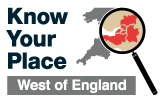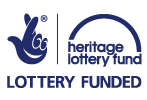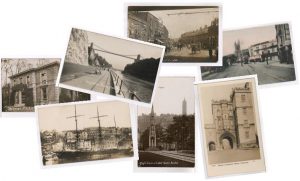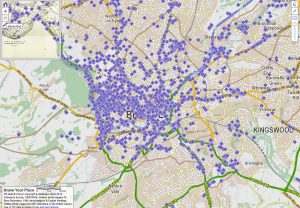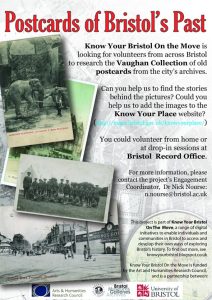Mapping Collections, Bristol Fashion: The Vaughan Postcards
Historic Mapping, the Vaughan postcard collection and community volunteers.
Our series of Workshops to map collections with confidence are continuing throughout May.
At our Bristol workshop, City Archivist Julian Warren shared the lessons learned from mapping the Vaughan Postcards Collection.
Here, he tells us more….
The Vaughan Postcards collection
The Vaughan collection consists of almost 10,000 postcards of Bristol, mainly from the early 20th century, deposited with Bristol Archives in 2005 and digitised by 2008.
A challenge common to such a collection is that it can be very difficult to navigate your way around the collection catalogue. But it is much easier to find such records on a map.
So creating a project to map these postcards onto Know Your Place offered a good solution to making this collection more accessible.
Start Small, think Big
The Vaughan postcard collection contains almost 10,000 postcards, which could seem a daunting amount of work for a project.
So we began with just two small albums – a 1906 photographic survey of property owned by Bristol Charities.
Julian’s Tip 1: Start with something small and manageable before moving to a more ambitious scale
Choose items with geographical spread
When deciding on our project, we needed to consider what collections would work well on Know Your Place.
Vaughan’s postcards are great as many have a Bristol ‘locative value’, meaning the features they show can be associated with geographical locations across the city.
But other collections, such as Bristol Museum’s collection of overseas Chinese pottery, for example, would not be so effective. For these we would only be able to map a single point on Know Your Place where they are stored and displayed in Bristol, not where they came from in China. This would provide no additional context apart from the fact that the collection is held at the Museum.
Julian’s Tip 2: Choose a collection that provides multiple locations to pin on the map.
Think about what preparatory work is needed
Before we began adding the collection onto Know Your Place, we needed to consider carefully what preparatory work we should do first.
Below are a list of questions worth asking yourself:
- Is the collection catalogued?
- Do individual items have reference numbers?
- Do you have permission to put these images in the public domain? (Ie. What is the ownership & copyright status?)
- Do you have digital files of an appropriate size? (Overly large files will slow the system down, and take a long time to open. Bristol Archives uses compressed jpeg files at a resolution of 700×700 – small but good enough to view photos on a small screen without pixelating too much.)
- How concerned are you that others will ‘rip’ your images off, and use them elsewhere? (This may determine what you choose to / not to publish.)
- Who in your team is available to get your collection ready for the project?
Julian’s Tip 3: Ask questions about your collection to determine what work and decision-making is needed to get them ‘map-ready’.
Establish a Workflow and Test it
We then thought through the process – and looked at the contribution form on Know Your Place – to identify what information we wanted to put where.
When adding a collection of many records, think about what consistency you want to apply to records from your organisation. Think about:
- What information would you like to publish about the image, or what kind of information might you need to research?
- How much information do you want to add? We asked volunteers to contribute anything between 2 sentences to 2 paragraphs; 50 – 500 words, but no more. KYP is not an appropriate platform for publishing a thesis!
- Are the dates/information accurate? What about spelling and punctuation? Try to be as accurate as possible in the content of your records, but don’t worry if facts/figures end up slightly wrong as someone will invariably get in touch to let you know! There is value for you in this, as you can increase your understanding of your collections with public input.
- Have you established who owns the copyright, and have you asked their permission to digitise and publish? As with all good collections management, you should be clear on the provenance and agreements associated with the collections you hold, and what you can and can’t do within these.
Julian’s Tip 4: Identify your work flow and test it with a small pilot project, to check you have covered everything.
Working with Volunteers
Bristol Archives was reliant on the help of volunteers to get the Vaughan collection on Know Your Place.
Working with volunteers raises a number of extra questions to consider:
- If you are using volunteers, how are you going to recruit, keep and train them? Research and uploading can be done independently, but some volunteers like the social aspect of work, so how will you support your volunteers?
We used flyers, social media, Family and Local History Societies, local press to recruit.
We held training sessions, and then had regular volunteer drop-in sessions (see: http://knowyourbristol.org/2014/03/24/the-second-video-blog-bristol-record-office).
It’s also worth realising that some volunteers will do lots, some will do less, depending on their interest and ability. But it all counts and is valuable learning, not just for you, but for your volunteers too.
Julian’s Tip 5: Think carefully about how you will recruit, train and support your team to add records in the way you want them to.
Project Vital Statistics
The Vaughan Collection is probably the largest single collection that has been mapped onto Know Your Place to date. This provides us with some impressive statistics:
- We spent 3 months planning and 2 years to complete the Vaughan postcard layer on KYP.
- There are 9,700 postcards in the Vaughan Collection
- Of these, over 3,500 postcards have now been located on Know Your Place
- The project involved 53 volunteers
- Our volunteer team included five ‘super’ volunteers, who each submitted more than 50 records onto the map
- We had one extraordinary volunteer, who submitted 66% of all records!
Julian’s Tip 6: Take your time, this allows you to deliver a larger, more considered project than if you rush to complete it.
Benefits of the Project
So was it worth it?
Working with volunteers on a regular basis allowed us to invest their resource into a much longer-lasting project than we could have achieved using just archive staff.
The number of people visiting the KYP website continues to increase and Bristol now receives around 12,000 visits a month, all of whom will be looking at our collections of maps and images. That’s over double the number of visitors to our searchroom we receive in one year! And since putting the postcards on KYP we receive more requests from people who would like to use them in other contexts – such as talks, publications and art work.
We have been lucky also, as one or two of the project volunteers have stayed with us, and are continuing to research, locate and upload further items from Bristol’s archives to Know Your Place, so the work goes on ….
And it’s been noticed by The National Archives, who have included it as a case study in their new national vision for archives.
Julian Warren is City Archivist at Bristol Archives.
For further information about the Archive’s work on Know Your Place contact: archives@bristol.gov.uk
